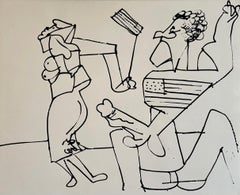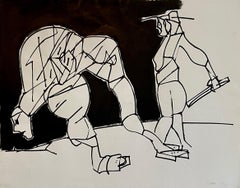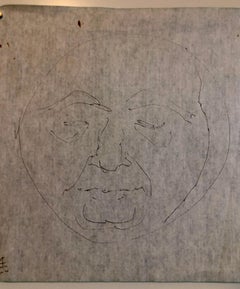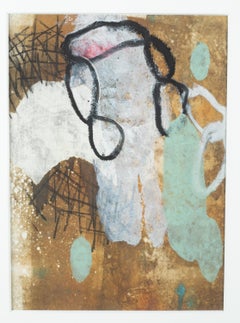Lions Gallery
1970s Abstract Expressionist Abstract Drawings and Watercolors
Watercolor, Ink
1970s Abstract Expressionist Abstract Drawings and Watercolors
Ink, Watercolor
1990s Abstract Expressionist Abstract Paintings
Canvas, Oil
20th Century Modern Figurative Drawings and Watercolors
Paper, Pencil
Early 2000s Contemporary Abstract Paintings
Mixed Media
1980s Post-Modern Abstract Sculptures
Stainless Steel
20th Century Abstract Expressionist Abstract Paintings
Acrylic, Canvas, Oil
20th Century Abstract Expressionist Abstract Paintings
Canvas, Oil
20th Century Surrealist Abstract Prints
Lithograph, Offset
20th Century Surrealist Figurative Prints
Etching, Aquatint
20th Century Surrealist Figurative Prints
Etching, Aquatint
20th Century Surrealist Figurative Prints
Etching, Aquatint
20th Century Surrealist Figurative Prints
Etching, Aquatint
20th Century Surrealist Figurative Prints
Etching, Aquatint
20th Century Surrealist Figurative Prints
Etching, Aquatint
20th Century Surrealist Figurative Prints
Watercolor, Etching, Aquatint
1960s Outsider Art Mixed Media
Metal
1980s Neo-Expressionist Abstract Paintings
Canvas, Oil Crayon, Oil
1980s Abstract Expressionist Prints and Multiples
Monoprint
1980s Abstract Expressionist Prints and Multiples
Aquatint, Etching
1990s Abstract Expressionist Abstract Paintings
Canvas, Oil
20th Century Modern Abstract Paintings
Oil, Board
Mid-20th Century American Modern Still-life Paintings
Canvas, Oil
Early 2000s Contemporary Abstract Photography
Photographic Paper, Mixed Media
20th Century Abstract Expressionist Abstract Paintings
Tape, Mixed Media, Oil
20th Century Modern Abstract Paintings
Oil, Board
20th Century Folk Art Figurative Paintings
Canvas, Oil
1980s Pop Art Abstract Paintings
Charcoal, Acrylic, Archival Paper
1980s Contemporary Interior Prints
Color, Etching
1960s Pop Art Abstract Prints
Screen
21st Century and Contemporary Neo-Expressionist Abstract Drawings and Wa...
Paper, Watercolor
21st Century and Contemporary Neo-Expressionist Abstract Drawings and Wa...
Paper, Watercolor
20th Century Abstract Mixed Media
Ink, Watercolor
1970s Modern Landscape Paintings
Canvas, Oil
20th Century Photorealist Still-life Paintings
Canvas, Acrylic
1980s Abstract Geometric Abstract Paintings
Canvas, Oil
1980s Abstract Expressionist Abstract Prints
Lithograph, Linocut
1960s Modern Mixed Media
Paper, Mixed Media
1980s Modern Abstract Paintings
Canvas, Mixed Media, Acrylic, Laid Paper
Mid-20th Century Black and White Photography
Photographic Paper
20th Century Modern Figurative Drawings and Watercolors
Ink, Watercolor, ABS
20th Century Modern Figurative Drawings and Watercolors
Ink, Watercolor, ABS
20th Century Modern Figurative Drawings and Watercolors
Ink, Watercolor, ABS
20th Century Modern Figurative Drawings and Watercolors
Ink, Watercolor, ABS
1980s Abstract Prints
Lithograph
Mid-20th Century Portrait Prints
Etching
Mid-20th Century Abstract Paintings
Paint
Mid-20th Century Expressionist Drawings and Watercolor Paintings
Lithograph
Mid-20th Century Expressionist Drawings and Watercolor Paintings
Lithograph
Early 20th Century Post-Impressionist Drawings and Watercolor Paintings
Etching
Early 20th Century Post-Impressionist Drawings and Watercolor Paintings
Etching
Early 20th Century Post-Impressionist Drawings and Watercolor Paintings
Etching
Early 20th Century Post-Impressionist Drawings and Watercolor Paintings
Etching
Early 20th Century Post-Impressionist Drawings and Watercolor Paintings
Etching
Early 20th Century Post-Impressionist Drawings and Watercolor Paintings
Etching
Early 20th Century Post-Impressionist Drawings and Watercolor Paintings
Etching
Early 20th Century Post-Impressionist Drawings and Watercolor Paintings
Etching
Early 20th Century Post-Impressionist Drawings and Watercolor Paintings
Etching
Early 20th Century Post-Impressionist Drawings and Watercolor Paintings
Etching
20th Century Modern Figurative Prints
Etching





